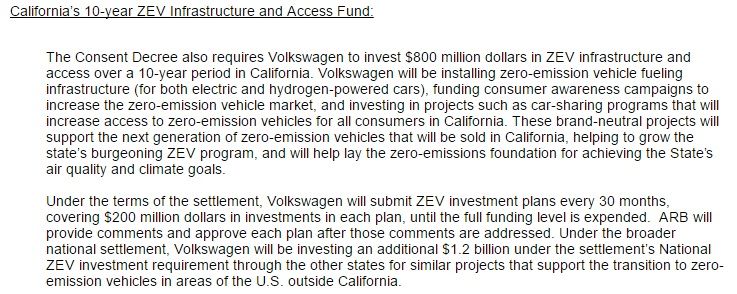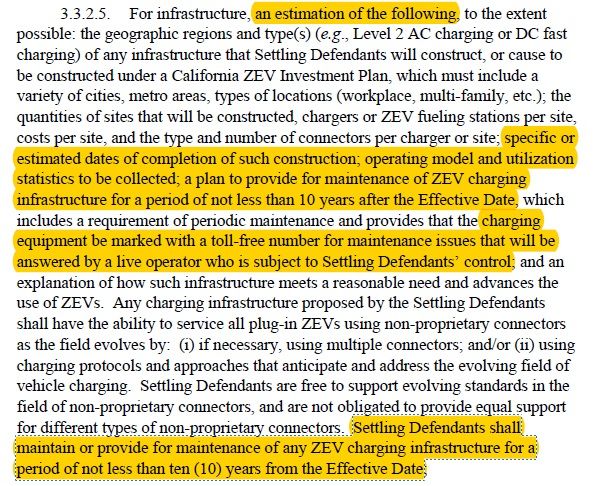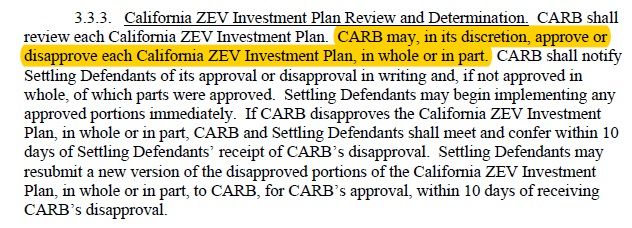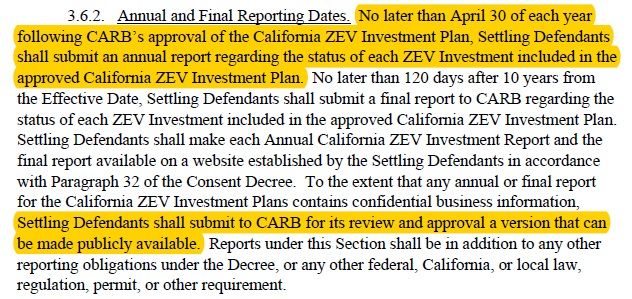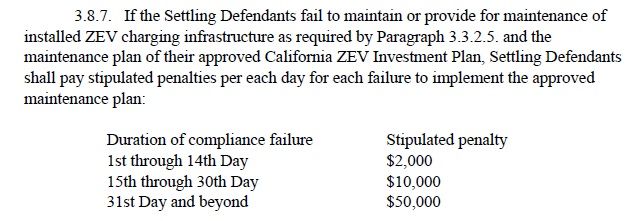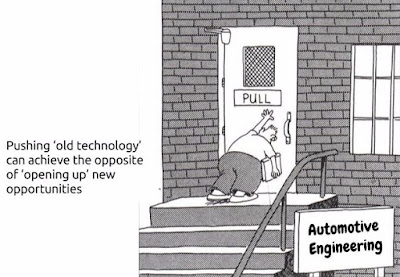I wanted to start a new thread about this settlement that is separate from the main VW Dieselgate thread. This is a very large sum of money, and given the amount and that some of it might end up in Hydrogen (No !) I believe the thread is appropriate for the "Energy, Environment and Policy" sub-forum.
The first good article that I saw on the web was at Green Car Reports. Here is the link:
How to use $2 billion VW diesel fine for electric-car charging: advocate offers advice
The financial aspect of this is that of the $2.0 billion, $800 million (40%) is coming to California, with the rest split across the rest of the country. The $800 million gets distributed at the rate of $200 million every 2.5 years. The funds are specifically designated for infrastructure for ZEV's.
The author goes on to discuss how the money will be used, and who will oversee the actual implementation. I found myself in agreement with his analysis of the current situation, and also his list of "pitfalls" to be avoided. I'll go into more detail concerning each of these below.
The authors first recommendation is to install a national network of DC fast chargers. He points out that Tesla has already essentially done this, which confirms that it is possible to roll out a national network of fast chargers that would enable any EV that is properly equipped for using them to travel long distances.
Looking at the cost of the Tesla Supercharger stations, I remember reading in a thread here that the cost per station might be $250,000. Even if you assume that the cost is double that, at $500,000 per station you are looking at a network that could be built that has 4,000 total stations in the U.S. The $800 million for California could build 1,600 stations. Right now Tesla has 282 Superchargers in the entire U.S., so the deployment of anywhere near the 1,600 in California or 4,000 in the U.S. would basically cover everyone's long distance travel, no matter where they happened to live, or wherever their destination. Given that this could be accomplished, it is imperative that it be done right.
The author suggests that Tesla might be interested in installing CSS and CHAdeMO stalls at their existing sites, and even maintaining the sites. I'm not sure that Tesla would be interested in doing this, for a variety of reasons. Tesla has already "figured out" how to not only build a nationwide network of Superchargers, they are doing it as we speak. Tesla has superior hardware compared to the CSS/CHAdeMO stations out there, both from an operational perspective (charging time, # of stalls, cable size !) and a cost perspective. Why would Tesla want to then sign up for installing and/or maintaining someone else's inferior hardware. And then, you have the problem of non-Tesla vehicles not working on the Tesla installed combo chargers for whatever reason, and it ends up on Tesla's plate to figure it out.
The abysmal state of DC fast charging compared to Tesla Supercharging almost doesn't even need to be stated, as anyone who follows the development of fast charging knows. I have personally used 3 CHAdeMO stations, all of which were located in non-freeway accessible locations. All had a single stall, supporting either CSS or CHAdeMO. Two of the three were free, and the other required a phone call (not if you have their card) and 5 minutes of discussion to get started charging. Others have pointed out that since no one is typically responsible for maintaining the stations, they often do not work, and break down frequently.
It has been my opinion for a long time now that the Tesla connector and Supercharger network would "by default" become the defacto EV charging standard. The sheer number of Tesla's that will be produced and the fact that they all (sorry Roadster's) can work on the same system that provides nationwide coverage I believe will make any other standard that is not as fast or that doesn't cover the same area obsolete the day they start building it. But unless somehow the other automakers decide to switch to the Tesla fast charging system, there are going to be multiple standards around for a while. You would hope that the people doling out the $2 billion for charging infrastructure spend some time pondering this. Maybe as EV's become more prevalent, and site owners can have a captive audience for 45 minutes, they will be the ones who end up maintaining the stations. With a gas stop only being 5 minutes, you see the basic convenience store model. For a 30-45 minute charging stop, many more possibilities arise.
The author also mentions workplace charging as a good area for investment. This covers the minority of people who either: 1) cannot charge at home but could buy an EV if they could charge at work, and 2) people whose round trip commute exceeds their EV range.
The author closes with the obvious argument that whatever system is deployed, it needs to be made future proof. Tesla's Supercharger network is already future proof: You can travel on long distance trips in your Tesla, provided there are Superchargers on your route. No other current DC fast charging system in combination with any other available manufacturers cars can make this claim. Stopping every 4 hours to charge for 30 minutes works, stopping every 1.5 hours to charge for 30 minutes does not work. All that has to be done is duplicate the Tesla ecosystem, or improve on it if possible.
I'll follow this up with additional comments as I find out about how the decisions will be made, who will be making them, and hopefully we might be able to have some influence on the process. Anybody planning on spending $0.01 or more of these funds on Hydrogen Fuel Stations with the idea that "if you build them, they will come" had better be ready to defend those decisions when there are 500,000 Tesla's on the road come the end of 2018 and 200 Mirai's.
RT
The first good article that I saw on the web was at Green Car Reports. Here is the link:
How to use $2 billion VW diesel fine for electric-car charging: advocate offers advice
The financial aspect of this is that of the $2.0 billion, $800 million (40%) is coming to California, with the rest split across the rest of the country. The $800 million gets distributed at the rate of $200 million every 2.5 years. The funds are specifically designated for infrastructure for ZEV's.
The author goes on to discuss how the money will be used, and who will oversee the actual implementation. I found myself in agreement with his analysis of the current situation, and also his list of "pitfalls" to be avoided. I'll go into more detail concerning each of these below.
The authors first recommendation is to install a national network of DC fast chargers. He points out that Tesla has already essentially done this, which confirms that it is possible to roll out a national network of fast chargers that would enable any EV that is properly equipped for using them to travel long distances.
Looking at the cost of the Tesla Supercharger stations, I remember reading in a thread here that the cost per station might be $250,000. Even if you assume that the cost is double that, at $500,000 per station you are looking at a network that could be built that has 4,000 total stations in the U.S. The $800 million for California could build 1,600 stations. Right now Tesla has 282 Superchargers in the entire U.S., so the deployment of anywhere near the 1,600 in California or 4,000 in the U.S. would basically cover everyone's long distance travel, no matter where they happened to live, or wherever their destination. Given that this could be accomplished, it is imperative that it be done right.
The author suggests that Tesla might be interested in installing CSS and CHAdeMO stalls at their existing sites, and even maintaining the sites. I'm not sure that Tesla would be interested in doing this, for a variety of reasons. Tesla has already "figured out" how to not only build a nationwide network of Superchargers, they are doing it as we speak. Tesla has superior hardware compared to the CSS/CHAdeMO stations out there, both from an operational perspective (charging time, # of stalls, cable size !) and a cost perspective. Why would Tesla want to then sign up for installing and/or maintaining someone else's inferior hardware. And then, you have the problem of non-Tesla vehicles not working on the Tesla installed combo chargers for whatever reason, and it ends up on Tesla's plate to figure it out.
The abysmal state of DC fast charging compared to Tesla Supercharging almost doesn't even need to be stated, as anyone who follows the development of fast charging knows. I have personally used 3 CHAdeMO stations, all of which were located in non-freeway accessible locations. All had a single stall, supporting either CSS or CHAdeMO. Two of the three were free, and the other required a phone call (not if you have their card) and 5 minutes of discussion to get started charging. Others have pointed out that since no one is typically responsible for maintaining the stations, they often do not work, and break down frequently.
It has been my opinion for a long time now that the Tesla connector and Supercharger network would "by default" become the defacto EV charging standard. The sheer number of Tesla's that will be produced and the fact that they all (sorry Roadster's) can work on the same system that provides nationwide coverage I believe will make any other standard that is not as fast or that doesn't cover the same area obsolete the day they start building it. But unless somehow the other automakers decide to switch to the Tesla fast charging system, there are going to be multiple standards around for a while. You would hope that the people doling out the $2 billion for charging infrastructure spend some time pondering this. Maybe as EV's become more prevalent, and site owners can have a captive audience for 45 minutes, they will be the ones who end up maintaining the stations. With a gas stop only being 5 minutes, you see the basic convenience store model. For a 30-45 minute charging stop, many more possibilities arise.
The author also mentions workplace charging as a good area for investment. This covers the minority of people who either: 1) cannot charge at home but could buy an EV if they could charge at work, and 2) people whose round trip commute exceeds their EV range.
The author closes with the obvious argument that whatever system is deployed, it needs to be made future proof. Tesla's Supercharger network is already future proof: You can travel on long distance trips in your Tesla, provided there are Superchargers on your route. No other current DC fast charging system in combination with any other available manufacturers cars can make this claim. Stopping every 4 hours to charge for 30 minutes works, stopping every 1.5 hours to charge for 30 minutes does not work. All that has to be done is duplicate the Tesla ecosystem, or improve on it if possible.
I'll follow this up with additional comments as I find out about how the decisions will be made, who will be making them, and hopefully we might be able to have some influence on the process. Anybody planning on spending $0.01 or more of these funds on Hydrogen Fuel Stations with the idea that "if you build them, they will come" had better be ready to defend those decisions when there are 500,000 Tesla's on the road come the end of 2018 and 200 Mirai's.
RT




